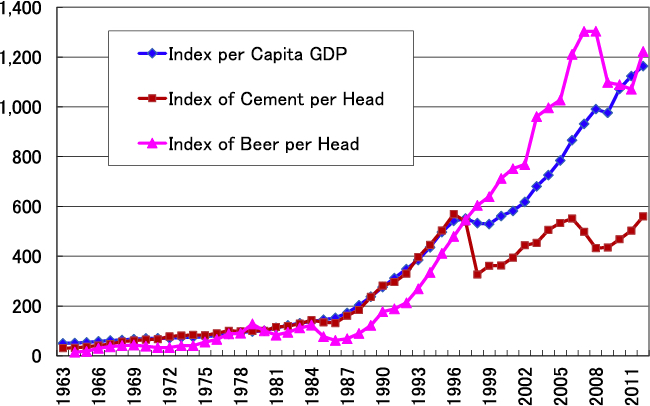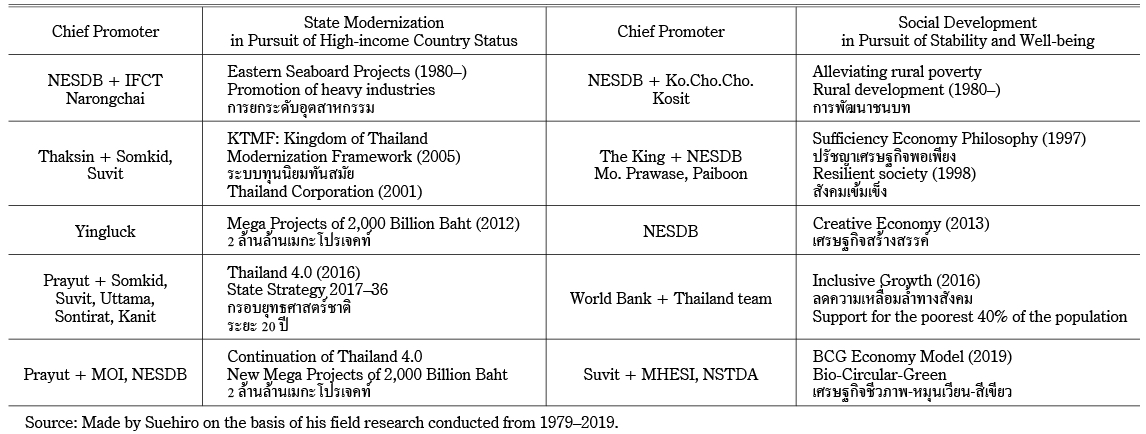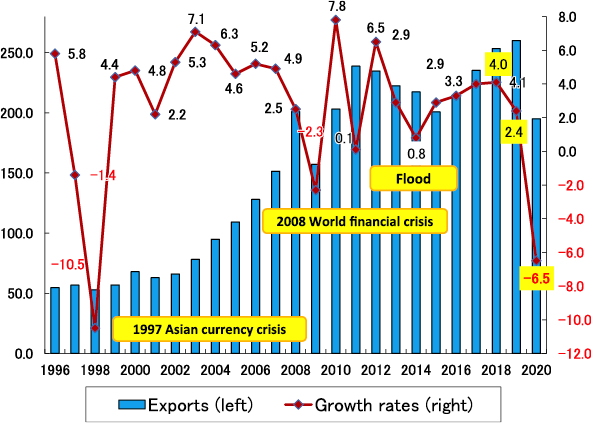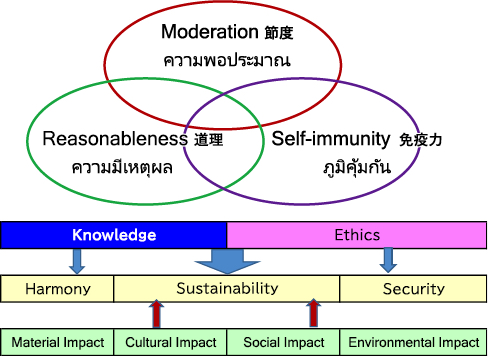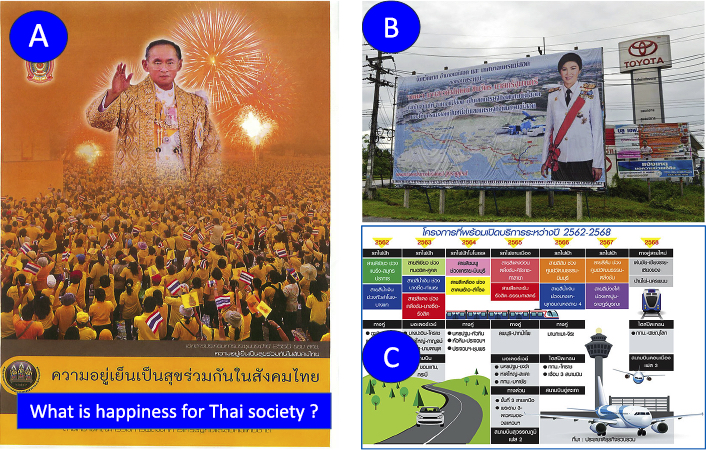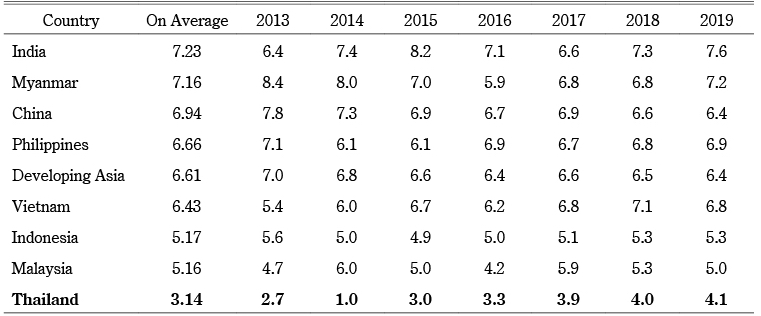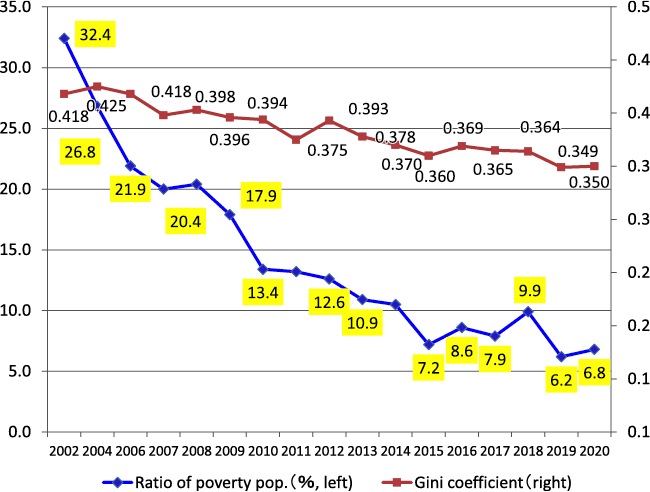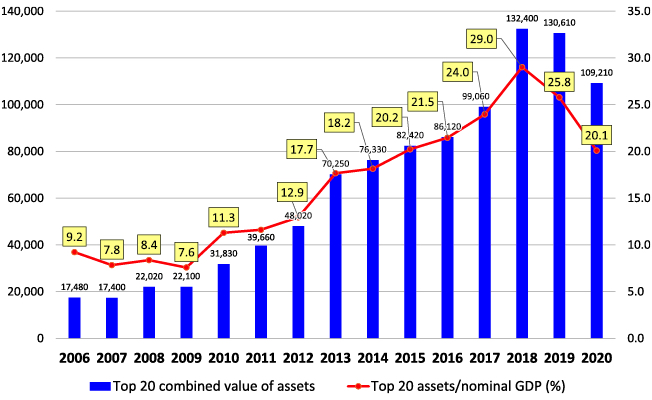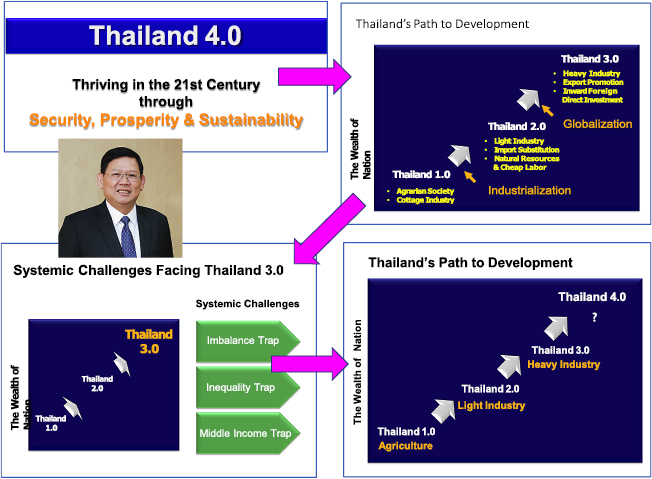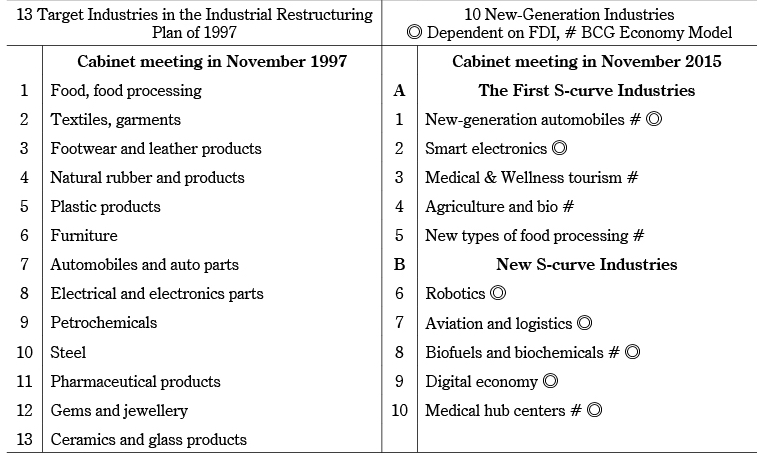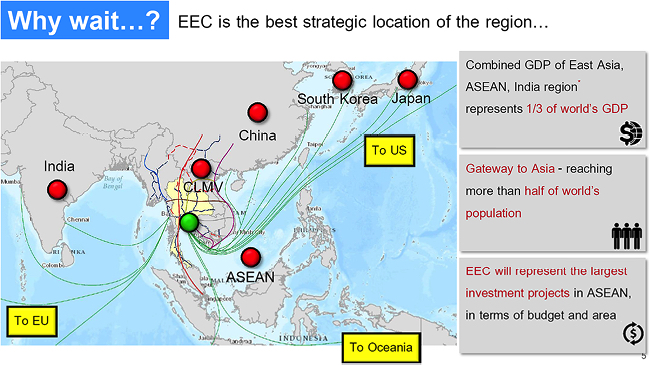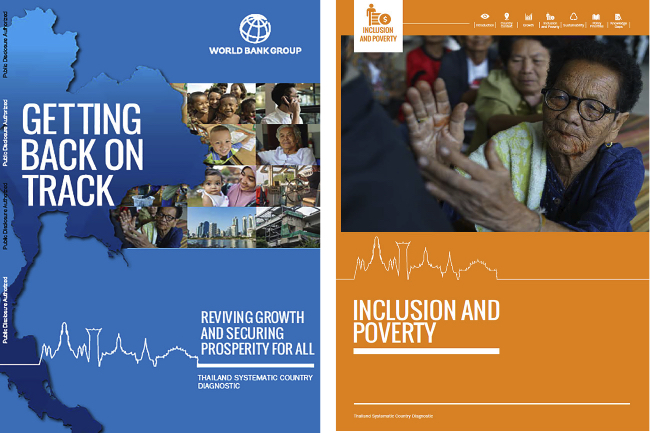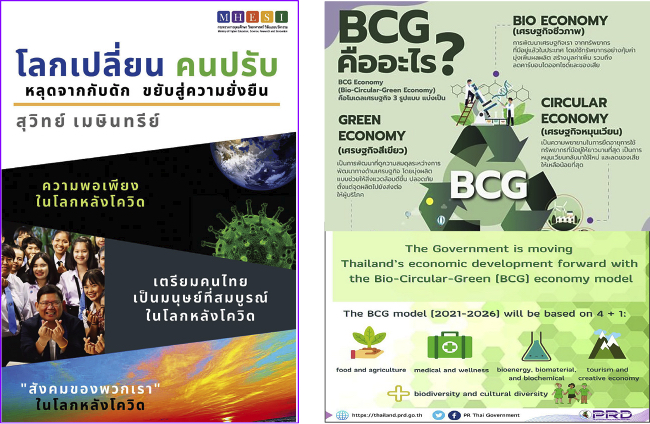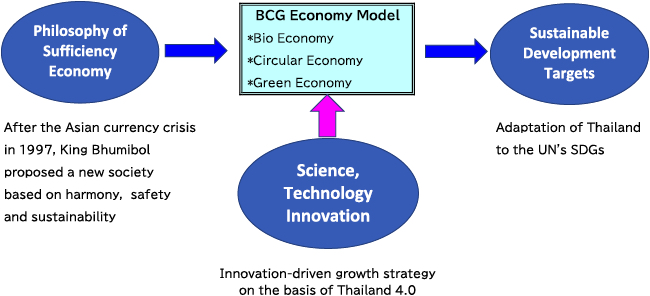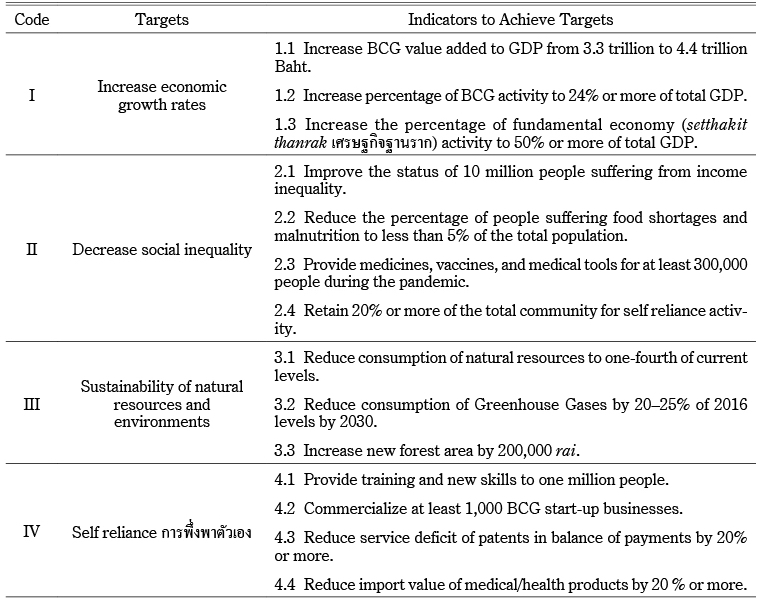Contents>> Vol. 12, Supplementary Issue
State Modernization vs. Social Development: Two Directions in Thailand’s Development
Suehiro Akira*
*末廣 昭, Professor Emeritus, The University of Tokyo
e-mail: asuehiro0830(at)gmail.com
DOI: 10.20495/seas.12.SupplementaryIssue_5
Following the currency crisis in 1997, Thailand has employed two different approaches to respond to external shocks to its economy. The first approach aims to construct a strong state that can effectively manage crises and seeks to become a high-income country through industrial upgrading. This approach was manifested in the Kingdom of Thailand Modernization Framework (KTMF) initiated by the Thaksin government. The second approach relies on more flexible social networks, favoring resilience rather than economic growth to ensure social development. The Sufficiency Economy Philosophy proposed by King Bhumibol was representative of this approach.
Tending to avoid extreme thought and actions, Thais have preferred a middle path when pursuing development policies. This is visible in the balancing act between the Eastern Seaboard Projects (typical of Newly Industrializing Countries) and Kosit’s rural development project (typical of Newly Agro-Industrializing Countries) in the early 1980s, and then again between the state strategy of Thailand 4.0 (2017–36) on the one hand, and the World Bank joint proposal for inclusive growth (2016) and the BCG Economy Model (2019), on the other. However, such Thai-style balancing policies have revealed their limitations in the face of structural problems, such as labor shortages due to the aging society and the lack of human resource development in the realm of digital innovation.
Keywords: Thai economic policy, state modernization, Sufficiency Economy Philosophy เศรษฐกิจพอเพียง, middle-income trap, Thailand 4.0, BCG (Bio-Circular-Green) Economy Model, external shocks, high-income country
I Introduction
I-1 From a Developing to a Middle-Income Country
“Thailand today is a very different country from Thailand a decade ago. The economic boom that began after 1985 has changed so much.” (Pasuk and Baker 1996, 1)
In describing Thailand’s unprecedented economic boom between 1987 and 1995, Pasuk Phongpaichit and Chris Baker emphasize change. Indeed, as Fig. 1 clearly demonstrates, Thailand has undergone dramatic changes both during that period and since.1) It uses three indicators to demonstrate this: 1) per capita GDP as an indicator of economic growth in general, 2) cement production per head as an indicator of industrial infrastructure development, and 3) beer production (≒consumption) per head as an indicator of improved living standards. It is interesting to note that beer production has consistently increased, even during the period of the Asian currency crisis (1997–2001). Apart from beer consumption for the sake of relief from stress, this suggests that the crisis did not disrupt people’s lives as much as the dramatic decline of GDP growth rates would indicate (see also Fig. 3).
Fig. 1 Changes in per Capita GDP, Cement Production per Head, and Beer Production per Head, 1963–2012 (1980 = 100)
Sources: Arranged by Suehiro, based on Bank of Thailand, Monthly Bulletin, Raingan setthakit raiduean, and Sathiti setthakit lae kanngoen respectively for the years 1963–2012.
In tracing the trajectory of Thailand’s socio-economic development for four decades (1958 to 1997), we may divide it into two major stages. The first stage is the era of a developing country with a set of national development (phatthana chat) policies that the Sarit government first put into motion in 1958 (Suehiro 1993, Chapter 1). With the start of economic boom in 1987, Thailand began to move into the next stage, the era of a middle-income country, and faced a variety of new problems. Fig. 2 compares the targets and the tasks for the Thai government in various sectors during these two different eras (Suehiro 2009; 2020).
During the National Development Era, the government set policy priorities in each sector as follows: import-substitution industrialization in the economic sector; rural development in the social sector; promotion of the non-agricultural labor force in the labor market; control of the population growth rate through family planning in the demographics “sector”; eradication of infectious diseases in the public health sector; and the extension of elementary and secondary education in the education sector. With these priorities, the government aimed to upgrade the economic status of Thailand from a lower-income country to a middle-income one.2)
By contrast, during the Middle-income Era, the government shifted policy targets to correspond to the progress of the developmental stage, thus prioritizing industrial upgrading in the economic sector; decreasing the income gap in the social sector; control of the informal labor force (raeng-ngan nokrabop แรงงานนอกระบบ) in the labor market; addressing the aging society in the demographics “sector”; responding to new diseases, such as cancers, diabetes, mental illnesses, and HIV-AIDS (Suehiro 2009, 123; 2014a, 200),3) in the health sector; and promoting and extending higher education to the masses.
I-2 Two Approaches to External Shocks
However, Thailand reached a turning point in the aftermath of the Asian currency crisis of 1997, which revealed vulnerabilities in the country’s economy as well as society (Natenapha 2006; Suehiro 2008a). The question of how Thailand should respond to such external shocks has continued to attract practical concern ever since. Following the currency crisis, two general approaches have emerged. The first approach aims to 1) construct a strong state that can effectively manage crises and 2) enhance the competitiveness of the country within the global capitalist system. A representative person who employed this approach is the former prime minister Thaksin Shinawatra. He proposed the idea of a strong state under the Kingdom of Thailand Modernization Framework (or KTMF), in which the government aimed to achieve high-income country status through reforms in the political system and economic activity. The second approach responds to external shocks with more flexible social networks based on traditional values originating in Buddhism. Representative of this approach is the Sufficiency Economy Philosophy (pratya setthakit phophiang ปรัชญาเศรษฐกิจพอเพียง), proposed by King Bhumibol Adulyadej, and the idea of resilient society (sangkhom khemkheng สังคมเข้มเข็ง), proposed by Mo Prawase Wasi immediately after the currency crisis.4)
In brief, Thaksin’s approach promotes a modernization of the state and is characterized by the keywords of competitiveness and efficiency in both the private and public sectors. Thaksin’s approach also prioritizes development in the business sector over social sectors. By contrast, King Bhumibol’s approach promotes the development of society and is characterized by the keywords of harmony and security in both society and individual lives (see Fig. 5 in Section II-3). The King’s approach prioritizes social stability rather than economic growth.
The two different approaches are not unique to the period of the Thaksin government (2001–06). Both can be traced back to the first half of the 1980s, when Thailand was recovering from a long-term economic recession due to two oil crises (in 1973 and 1979). The Prem Tinsulanond government (1980–88) introduced industrial policies to promote heavy industries based on natural gas, which had been discovered in the Gulf of Thailand in 1973. The promotion of such heavy industries, in addition to export-oriented industries such as garments, was considered the most suitable policy for Thailand to overcome the long-term recession. This policy agenda was supported by the industrial promotion group within the National Economic and Social Development Board (NESDB) as well as by neo-classical economists, led by Dr. Narongchai Akarasenee.5)
On the other hand, the economic recession in the early 1980s had seriously damaged the rural economy. Moreover, the promotion of heavy industries required a huge amount of foreign investment. To address these concerns, a group led by Kosit Panpiemras in the NESDB proposed a counter-balancing approach of rural development (kan phatthana chonnabot การพัฒนาชนบท), in which the government would strategically allocate budget to reduce rural poverty and to promote agro-industries that depended on domestic resources.6) By the mid-1980s, the former group had joined the Committee to Promote the Eastern Seaboard Projects set up in December 1980, while the latter participated in the National Committee for Rural Development (Ko.Cho.Cho. ก.ช.ช.) in 1981.
Looking at these two groups, it is possible to say that the former group promotes an industrialization typical of Newly Industrializing Countries (NICs) and the latter group promotes a development typical of a Newly Agro-Industrializing Country, or NAIC (Suehiro and Yasuda 1987). The two approaches—of NIC- and NAIC-style development—overlapped during the 1980s (during the Prem government). From the author’s observation, these two approaches seem to have been employed in a mutually complementary manner rather than a mutually exclusive one in the process of overcoming the long-term economic recession.
Table 1 compares the various iterations of the two approaches—of state modernization and social development—in responding to external shocks during each critical period since 1980. These include industrial upgrading (via the Eastern Seaboard Projects) vs. rural development (a la NAIC) in the 1980s; Thaksin’s modernization vs. King Bhumibol’s self-sufficiency in the first half of the 2000s; Thailand 4.0 proposed by Somkid’s economic technocrat team vs. the inclusive growth approach proposed by the World Bank Group in 2016; and Thailand 4.0 vs. the BCG (Bio-Circular-Green) Economy Model under the Prayut Chan-o-cha government.
Table 1 Two Approaches (1980 to today)
It should be noted here that the governments of both Yingluck Shinawatra (Thaksin’s youngest sister) and Prayut (who is principally anti-Thaksin in political stance) have followed Thaksin’s approach of promoting state-sponsored mega projects in pursuit of high-income country status.7)
I-3 Structure of the Paper
This paper presents three comparisons to illuminate the two different approaches during each critical period. Section II compares Thaksin’s framework for modernization (the KTMF) with King Bhumibol’s Philosophy of Sufficiency Economy following the 1997 currency crisis. Section III compares two strategies to escaping the middle-income trap: 1) the productive, or innovation-driven, growth engine strategy of the Thailand 4.0 plan, and 2) the inclusive growth engine strategy submitted by the World Bank Group in 2016. Section IV compares Thailand 4.0 with the BCG Economy Model in the wake of the international pressures of COP 26 and the SDGs. Finally, Section V examines the limitations of the two different approaches given the changing circumstances and suggests the need to introduce a new agenda for the survival of Thailand in the future.
II Thaksin’s Modernization Framework (KTMF) vs. King Bhumibol’s Philosophy of Sufficiency Economy
II-1 Thaksin’s Economic Reforms and Thaksinomics
Thaksin Shinawatra came to power in 2001 and was exiled from Thailand after the military coup d’état in September 2006. He has been attacked by mass media and anti-Thaksin groups for extreme power concentration, political nepotism, and corruption. However, very few scholars have focused on his ambitious reforms, which aimed to transform the Kingdom of Thailand from a traditional bureaucratic polity into a modern, strong state on a par with an emerging middle-income country within global capitalism (Suehiro 2014b, 299).8)
By the time Thaksin won the general election in January 2001, Thailand’s economy had begun to show signs of restoration from the economic recession caused by the currency crisis. As Fig. 3 indicates, the annual growth rate, which dropped from 5.8% in 1996 to –10.5% in 1998, had recovered to the level of 4.4% in 1999. Nevertheless, under the strict control of the IMF and the World Bank on fiscal expenditures, there were still no signs of strong recovery. The NESDB therefore decided to set target growth rates at 4.0% to 5.0% during the period of the Ninth National Economic and Social Development Plan (2002–06).9) However, growth rates under the Thaksin government exceeded the NESDB targets, reaching 5.3% in 2002, 7.1% in 2003, and 6.3% in 2004 respectively (Suehiro 2009, 160; 2014b, 306).
Fig. 3 Overview of Thailand Economy, 1996–2020 (USD Billion, %)
Sources: Compiled by Suehiro based on economic data compiled by the Bank of Thailand and the Asian Development Bank.
Note: The scale of exports is shown on the left-hand side (in Billion USD) and growth rates on the right-hand side (%).
What were the major elements contributing to such economic performance under Thaksin’s premiership? One possible answer to this question is his unique combination of promoting a grassroots economy in rural areas with favorable treatment of investments by big firms in urban areas, or the so-called dual-track policy (nayobai khwapkhu นโยบายควบคู่). The promotion of a grassroots economy included provision of village funds, credit supply through people’s banks, a debt moratorium for rural people, the one tambon one product, or OTOP, scheme, and 30-Baht universal medical services (Thailand, NESDB 2005; Suehiro 2009, 159–167). On the other hand, favorable treatment of big firms included mobilization of foreign capital through reform of the stock market, investment promotion through the National Competitiveness Plan, and securitization of state-owned-assets. Together, all these policies and reforms were called Thaksinomics.10)
Several scholars have noted that Thaksin’s political style adheres to the concept of a future Thai leadership (khwam pen phunam ความเป็นผู้นำ) proposed by Somkid Jatusripitak, who headed the economic policy team of Thaksin’s political party Thai Rak Thai.11) Somkid was appointed Deputy Prime Minister fully responsible for economic matters when Thaksin organized his Cabinet.
Thaksin also frequently and publicly expressed his idea that “a state is a company, and a prime minister is the CEO of the country” (Pran 2004, 223–233; Pasuk and Baker 2004, 101). This implies that the prime minister, like a CEO, is fully responsible for both the ultimate decisions in implementing company (or in this case, country) strategy and high-level personnel management. Furthermore, Thaksin ordered all government agencies and officers to report their missions, goals, and performance every three months (under the “principle of three months”) in the same way that board members of a private company must submit a quarterly financial report on their performance to all the shareholders (Suehiro 2008b, 241).
Thaksin’s principal concern was to ensure Thailand’s competitiveness within the new wave of globalization. With this aim, he asked Michael Porter, a renowned professor of the Harvard Business School, to advise (in the capacity of special advisor to the prime minister) on a National Competitiveness Plan that would refer to the concepts of the American business school.12) Thaksin’s priority to enhance Thailand’s competitiveness in the world market came, however, at the expense of national defense budget allocations.
From Thaksin’s point of view, arms competition seemed to be an old-fashioned product of the Cold War and he therefore had little interest in adding to the national defense coffers.13) Indeed, as the Fig. 4 demonstrates, total budget allocations for national defense hardly increased during Thaksin’s tenure in spite of the fact that the total government budget increased from 860 billion Baht in 2000 to 1,250 billion Baht in 2005. As a result, the percentage of national defense allocations against total budgets significantly declined from 16.0% in 1991 to 8.9% in 2000 and 6.2% in 2005 (Suehiro 2008b, 262–263). Naturally, such a policy caused strong dissatisfaction among the military group.
Fig. 4 The National Defense Budget and the Thaksin Government, 1991–2020 (Million Baht)
Sources: Made by Suehiro based on Thailand, Bureau of the Budget, Thailand’s Budget in Brief, various issues.
II-2 Thaksin’s Political Reforms and Modernization Framework
As mentioned earlier, Thaksin employed a dual-track economic policy. While his promotion of a grassroots economy contributed to his rising popularity, populist-oriented policies and projects were only one aspect of his overall approach. Moreover, especially following February 2005, when his Thai Rak Thai Party won 377 out of a total of 500 seats in the House of Representatives in the general election, Thaksin prioritized the second track of his approach: the promotion of big business groups in urban areas.
Thus began the second stage of Thaksin’s state reforms (in 2005). First, he launched an ambitious plan to reorganize Thailand as a modernized state suited to the economic status of a middle-income country. In his eyes, Thailand’s political regime, bureaucracy, and public services were outdated (lasamai ล้าสมัย) and such old-fashioned ways and institutions would isolate Thailand from global capitalism. According to his thinking, an economically advanced country must reform its institutions, practices, and social values in line with the new circumstances, just as a modern corporation needs to reform its management to keep up with the times (Suehiro 2014b, 301–302).
Thaksin’s Kingdom of Thailand Modernization Framework (KTMF) was precisely a product of his strategy to ensure Thailand’s survival within global capitalism and he often employed key words such as Knowledge, Technology, Management, and Finance when explaining the essence of the KTMF. Thaksin presented the KTMF to over 1,000 foreign and domestic investors at the prime minister’s residence in December 2005,14) where he provided an outline of mega projects amounting to 1,800 billion Baht (45 billion US dollars).
The KTMF planned to allocate investments for the following sectors: energy projects (23.6% of the total), transportation (18.4%), mass transport, including a subway and the BTS Skytrain in Bangkok (16.9%), housing (13.8%), water resources (11.7%), education (5.7%), and public health (5.6%). So far as investment funds were concerned, the government estimated that it could source 628 billion Baht (or 36.9%) from borrowings, 247 billion Baht (14.5%) from state enterprise revenues, 172 billion Baht (10.1%) from securitization of state-owned assets, and the remainder (38.5%) from private firms investments (Suehiro 2008b, 258–259).
Thaksin recognized two major obstacles in promoting the KTMF: (i) the ineffective services of the public sector due to the rigidity of the traditional bureaucracy, and (ii) the existing budget system, which was under the strict control of line ministries. For these reasons, Thaksin accelerated reform of the public sector under the auspices of the Public Sector Development Commission (PSDC), which had been established in October 2002. At the same time, he launched a radical reform of the budget system based on the concept of Strategic Performance Based Budget System (SPBBS), replacing the former Planning Programming Budget System (PPBS), which was based on line minister requests (Suehiro 2008b, 255–273; 2014b, 324–334).
The naming of the KTMF (which used the Kingdom of Thailand rather than simply Thailand) seemed to imply that the final target of the reform process would be the political regime, although Thaksin had no intention of eventually changing the existing regime of democracy with the King as the head of the state (kan pokkhrong rabop prachathipatai an-mi phramahakasat songpen pramuk การปกครองระบอบประชาธิปไตย อันมีพระมหากษัตริย์ ทรงเป็นประมุข). Aside from his cautious political stance, Thaksin did frequently demonstrate behavior that mirrored King Bhumibol, such as giving his mercy to common people. Such activity inevitably made it seem that Thaksin would challenge the King as another father of the country, which in turn resulted in the movement to kick him out of the political arena (McCargo 2009; Puangchon 2020). In the long run, Thaksin’s activity, including power concentration, state reforms, and challenging traditional values, resulted in a military coup d’état led by Army Commander-in-Chief General Sonthi Boonyaratglin in September 2006. However, the political leaders that followed Thaksin did not abandon his ideas. Indeed, his plan to invite foreign capital to invest in mega projects was reproduced by the Yingluck, Abhisith Vejajiva, and Prayut governments.
II-3 King Bhumibol’s Sufficiency Economy Philosophy (SEP)
Thaksin’s modernization reforms and dual-track economic policy were a response to the external shock of the economic recession caused by the Asian currency crisis of 1997. Another response to the same external shock emerged in the immediate aftermath of the currency crisis. This was King Bhumibol Adulyadej’s Sufficiency Economy Philosophy, or setthakit phophiang (เศรษฐกิจพอเพียง), which he introduced in the annual address given on the day before his birthday that was given at Dusit Palace December 4, 1997 and broadcast to a nationwide television audience. In his speech, the King proposes new priorities:
Recently, so many projects have been implemented, so many factories have been built, that it was thought Thailand would become a little tiger, and then a big tiger. People were crazy about becoming a tiger. . . . Being a tiger is not important. The important thing for us is to have a sufficient economy. A sufficient economy means to have enough to support ourselves. . . . It doesn’t have to be complete, not even half, perhaps just a quarter, then we can survive. . . . Those who like modern economics may not appreciate this. But we have to take a careful step backwards. (UNDP 2007, 20)15)
The “tiger” that the King mentions is a reference to hopes that Thailand would become the fifth Asian tiger following the four Asian NIES tigers of South Korea, Taiwan, Hong Kong, and Singapore. In its famous 1993 report The East Asian Miracle, the World Bank identified Thailand as a new tiger, designating it a High-Performance Asian Economy, or HPAE (World Bank 1993). One year later, R. Muscat, an American development economist with many years of experience in Thailand, also christened the country the “Fifth Tiger” (Muscat 1994). However, as we see by the above quote, the King seemed to dismiss these ambitions as hubris, and explicitly told Thailand that it needed to rethink the direction of the national economy and people’s lives.
Originally, the Sufficiency Economy was not an economic policy compiled in the National Economic Development Plan, but rather a kind of philosophy (pratya ปรัชญา) to guide the direction of economic life. The word phophiang itself comes from the Buddhist teachings that attribute wanting little with contentment (少欲知足論) (Nonaka 2009, 139). The main concepts of the Sufficiency Economy Philosophy (SEP) are depicted in Fig. 5. In SEP, three major tools of moderation, reasonableness, and self-immunity help to achieve three goals of harmony, sustainability, and security. Self-immunity refers to the social capability to respond to external shocks. The SEP does not propose a return to the self-sufficiency economy of ancient times, but rather attempts to create a social reliance, or ability to deal with various external shocks that confront society and the people. In other words, the SEP suggests ways for people to effectively manage the serious impacts of globalization on their lives, society, and environment, while also providing a roadmap to achieve a harmonious, secure, and sustainable society.
Fig. 5 The Concept of King Bhumibol’s Sufficiency Economy
Source: Made by Suehiro on the basis of UNDP (2007, 30).
Before the crisis, King Bhumibol began an experimental farming project in Saraburi Prefecture to demonstrate his idea of integrated agriculture (kankaset phasom phasan การเกษตรผสมผสาน). A 2.4-hectare farm was divided into four zones: (i) 30% for rice cultivation; (ii) 30% for fruits and other crops; (iii) 30% for a pond to supply water in the dry season and to cultivate fish; and (iv) 10% for housing and animal husbandry (UNDP 2007, 28). This idea of integrated agriculture was further developed as a royal theory of agriculture and was introduced to rural people after the crisis.16)
In 1998, the Ministry of Interior began an SEP campaign via local governments, while the Ministry of Education ordered primary schools to introduce integrated agriculture according to the SEP.17) In the 14 months from December 1999 to January 2001, the Ministry of Education disseminated 25,000 pamphlets introducing the King’s new theory of agriculture. The pamphlets were reprinted six times, a record in Thailand’s publishing world (Thailand, Ministry of Education and Ruam Duai Chuaikan Printing House 2001).
By the beginning of the year 2000, the NESDB had designated the SEP as the core concept to promote in the Ninth National Economic and Social Development Plan (2002–06). Incidentally, the commencement of this Five-Year Plan overlapped with the second year of the Thaksin government. As mentioned above, Thaksin was adopting a new state strategy that was diametrically opposed to the SEP. For example, Thaksin promoted profit-making agriculture rather than organic integrated agriculture. He also ordered the development of fossil fuels using latest technology rather than clean energy based on natural resources.
Under the Thaksin administration, the NESDB was asked to simultaneously carry out two different types of national development, namely, Thaksinomics and the SEP under royal patronage.18) Following the military coup d’état in September 2006, the Tenth National Economic and Social Development Plan (2007–11) put more emphasis on the SEP, and a specific sub-committee to promote the SEP inside the NESDB was formed (see Photo 1). In 2007, the SEP was officially authorized through its inclusion in Section 83 of Chapter V (Directive Principles of Fundamental State Policies) of the 2007 Constitution of the Kingdom of Thailand under the auspices of the military junta (Suehiro 2009, 135).19)
Photo 1 Two different approaches: (A) King Bhumibol’s philosophy of Sufficiency Economy in the Tenth National Economic and Social Development Plan (2007–11). (B) In 2013, Yingluck proposed a “Thai Silk Road” from Mae Sot through Myanmar to Europe. (C) Prayut’s 2019–25 plan includes highways, railways, and airport projects.
Sources: (A) Thailand, NESDB (2007); (B) Photo by the author in Tak Prefecture; (C) Prachachat Thurakit (2018).
In economic terms, the SEP has hardly contributed to Thailand’s GDP. However, the SEP seems to have functioned as a barometer to check the fairness of the country’s economic direction in reference to the context of its social development. Indeed, the idea of the SEP has been endorsed by the Social Investment Fund (SIF) program, which was introduced immediately after the Asian currency crisis in collaboration with NGO groups, as well as by the social policy group of the World Bank.20) Likewise, under the Prayut government, the idea of the SEP has been partially reproduced in the approach of the inclusive growth engine (see Section III) and the BCG Economy Model (see Section IV).
III Thailand 4.0 vs. the Inclusive Growth Approach
III-1 Economic Stagnation and Expanding Income Inequality
Since the 2006 military coup d’état, Thailand has suffered long-term economic stagnation, except in the years of 2010 and 2012 (see Fig. 3). Table 2 provides us with economic data to see this point more clearly. As we see in Fig. 1, Thailand enjoyed an unprecedented economic growth until 1996. However, entering the 2010s, Thailand began to show the lowest economic performance not only among ASEAN countries, but also among other emerging Asian economies, such as China and India. Thus, by the mid-2010s, economists have insisted that Thailand has been caught in the middle-income trap.21)
Table 2 Annual Economic Growth Rates of Major Asian Countries, 2013–19 (%)
Source: Made by Suehiro based on ADB (April 2018, 310).
Notes: 1) Actual figures for 2013 to 2016, temporary figure for 2017, and projected figures for 2018 and 2019; 2) Asian NIES, including Singapore, are omitted from this table; 3) “Developing Asia” refers to countries (economies) in Asia excluding advanced countries (economies) in terms of per capita GDP.
22) The ADB’s pioneering report (2012) analyzed rising economic inequality in Asian countries and included, for the first time, the current situation of each country, the major causes, and policy recommendations.
Causes of the middle-income trap for any given country cannot be attributed to a single factor. However, it is safe to say that a common phenomenon shared among countries experiencing the middle-income trap is a development pattern of dependence on low-cost advantage. In other words, these countries continue to follow a development pattern that depends on continuous input of cheap labor and low-cost capital funds without increasing productivity or improving investment efficiency (Gill and Kharas 2007; ADB 2017). Under these conditions, once wages begin to rise, growth rates inevitably slow down. Thailand is exactly such a case.
In addition to long-term economic stagnation, Thailand has experienced another serious problem, that is, increasing economic inequality. Fig. 6 depicts changes in both the proportion of the population living in poverty and the Gini coefficient during the period from 2002 to 2020. For decades, poverty reduction has been one of the most important national targets for successive governments in Thailand to achieve. However, Prime Minister Thaksin declared an end to the war against poverty and shifted policy priority to extending welfare services to the lower income classes (Suehiro 2008b, 253–255; Oizumi 2008). The percentage of the population living in poverty subsequently—and impressively—decreased from 32.4% in 2002 to 6.8% in 2020. However, the Gini coefficient experienced no significant changes during the same period (although the figure slightly declined from 0.418 in 2002 to 0.350 in 2020). Usually, if the Gini coefficient in a certain country exceeds 0.350, the country concerned is defined as less equal in terms of income distribution. Thailand doubtlessly belongs to a category of countries with unequal income distribution.22)
Fig. 6 Percent of Population Living in Poverty and the Gini Coefficient in Thailand, 2002–20
Sources: Made by Suehiro based on the World Bank online data for the Gini coefficient and the 2002–20 issues of the Thailand, NESDB (NESDC)’s Phawa Sangkhom Traimat for poverty data.
Fig. 7 clearly demonstrates the state of economic inequality in contemporary Thailand. To grasp the degree of economic concentration, the combined market value of the assets of the 20 richest families (based on data from Forbes) was computed as a percentage of Thailand’s nominal GDP. It is striking that the assets have rapidly increased from 7.6% of GDP in 2009 to 18.2% in 2014 and 29.0% in 2018. Hewison (2019) has also studied the progression of economic concentration by using income data from the Gini Index (1981–2017) and surveys by Forbes (2006–20) on the wealth growth of Thailand’s 50 richest families. Moreover, according to the Global Wealth Databook 2018, the wealthiest 1 percent of Thailand’s population accounted for 66.9% of the total assets in Thailand, which was ranked the worst among 40 surveyed countries (Credit Suisse Research Institute 2018, 156, Table 6-5) for wealth distribution equality.23)
Fig. 7 Thailand’s Richest 20 Families and Economic Concentration, 2006–20 (Million USD, %)
Sources: 1) Suehiro database based on Forbes’ “Thailand’s 50 Richest List” (2006–20); 2) Hewison (2019, 262–277); 3) World Bank Indicators online data, accessed on July 18, 2020.
III-2 The State Strategy of Thailand 4.0
In a lecture at the Asian Institute of Technology in 2016, Suvit Maesincee pointed to two major reasons to formulate a new national strategy for Thailand. The first was the need to follow advanced countries in formulating national strategies, such as the “A Nation of Makers” strategy in the United States, “Design Innovation” in the United Kingdom, “Smart Nation” in Singapore, and “Creative Economy” in South Korea. Key words commonly shared among these strategies are innovation and information technology (Suvit 2016, slides 2 to 7).24) The second reason for a new strategy was the need to overcome the middle-income trap explained above.
In this context, the Prayut government announced the new state strategy of “Thailand 4.0” in mid-2016, two years after the military coup d’état. Interestingly, several members of the economic team that introduced the idea of Thailand 4.0 were members of the economic team in the Thaksin government. Leading figures are: (i) Somkid Jatusripitak, who served as Deputy Prime Minister responsible for economic matters in both the Thaksin and Prayut governments; (ii) Suvit Maesincee, who served as Vice Minister of Commerce in the Thaksin government and was appointed Minister attached to the Prime Minister’s Office in December 2016;25) (iii) Uttama Savanayana, who served as Minister of Information and Communications between August 2015 and September 2016 (and later, Minister of Industry from December 2016 to January 2019 and Finance Minister from July 2019 to July 2020); and (iv) Sontirat Sontijirawong, who was appointed Minister of Commerce in November 2017 (and later served as Energy Minister) (Suehiro 2018, 91).
The concept of Thailand 4.0 came from the German government’s idea of “Industry 4.0.” Industry 4.0 refers to a new stage of manufacturing industries on the basis of Artificial Intelligence (AI), the Internet of Things (IoT), and smart factories, as opposed to “Industry 1.0,” which was based on factory production using water and steam as energy sources, “Industry 2.0,” which was based on mass production using electricity, and “Industry 3.0,” which was based on flexible production using computer systems (Suehiro 2018, 87–89).
While “Industry 4.0” focused on the manufacturing production system, “Thailand 4.0” considers changes in the overall economic system, as follows: Thailand 1.0 was based on agriculture; Thailand 2.0 on light industry and import substitution; and Thailand 3.0 on heavy industry and export promotion. In this conceptualization, Thailand 4.0 marks a new stage of the economic system, one characterized by innovation through IT and the digital economy. The prototype of Thailand 4.0 was proposed by Suvit in 2016 as depicted in Fig. 8. The idea was then further developed into a master plan for “Thailand Industry 4.0” by the Ministry of Industry in October 2016. Fig. 9 summarizes the Ministry’s plan, including its background, three major traps, three major growth engines to overcome these traps, and projected economic outcomes. The plan begins by confirming Thailand’s poor performance in the industrial sector during the previous decade (2006–15), with the indicators of sluggish increases in annual industrial growth rates (3.0%), investments in manufacturing (2.0%), and manufactured exports (5.4%), and total factor productivity, or TFP (0.7%). The slow growth in TFP, in particular, is a major factor contributing to Thailand’s long-term economic stagnation.
Fig. 8 The Original Idea of Thailand 4.0 Proposed by Suvit Maesincee
Source: Arranged by Suehiro on the basis of Suvit’s lecture at the Asian Institute of Technology, Suvit (2016).
Fig. 9 Thailand 4.0 and Long-Term Economic Strategy, 2017–36
Source: Made by Suehiro based on Thailand, Ministry of Industry (2016).
Note: * “Productive growth engine” is translated from “innovation-driven engine” in Thai language.
Such poor performance indicators may be attributed to three major traps that Thailand had been experiencing for the previous decade, namely, the middle-income trap, the inequality trap, and the imbalance trap (of growth vs. the environment). To overcome these traps, the government introduced three major growth engines (konkai khapkhluan khwam mangkhang กลไกขับเคลื่อนความมั่งคั่ง): the productive growth engine, the inclusive growth engine, and the green growth engine (Thailand, Ministry of Industry 2016, 5).26) According to the Thailand 4.0 strategy, if the government successfully promotes these growth engines, Thailand can be expected to shift from an upper-middle income to a high-income country by 2036 (Thailand, Ministry of Industry 2016, 23–24).
In addition to these strategies, the government also reorganized the existing Thailand 3.0 production system, which was based on commodities, industries, and trade in goods, to a new production system based on innovation, technology and creativity, and trade in services. Finally, during the next twenty years, Thailand 4.0 plans to shift the foundation of the economy from manufacturing industries centering on electronics and automobile production to a digital economy accompanying next-generation strategic industries (see Table 3).
Table 3 Comparison of 13 Target Industries (1997) and 10 Target Industries (2015)
Sources: Made by Suehiro based on Suehiro (2010, 147) and Thailand, Ministry of Industry (2016, 10–12).
The Thailand 4.0 plan thus targets 10 strategic industries for development, which are divided into two groups (Thailand, Ministry of Industry 2016, 9–12). The first is a group of five existing industries (the First S-curve), which should be reshaped in accordance with the progress of new technologies. This group includes: (1) new-generation automobiles, including plug-in hybrid and electric vehicles (PHEVs and EVs); (2) smart electronics, such as flexible printed circuits and microelectronics design; (3) medical and wellness tourism; (4) agriculture and bio (biotechnology); and (5) new types of food processing, such as medical food and food supplements. The second group consists of future-oriented industries (New S-curve) that should be newly targeted for development. These include: (6) robotics; (7) aviation and logistics, including MRO (maintenance, repair, and overhaul) for the aerospace industry; (8) biofuels and biochemicals; (9) the digital economy, including data centers, smart cities, and creative media and animation; and (10) medical hubs.
When comparing these strategic industries with the 13 target industries in the Industrial Restructuring Plan (1997) of the Chuan Leekpai government, we see the ambitious aim of the Prayut government to focus on next-generation industries rather than export-oriented labor-intensive industries, such as textiles, garments, sport shoes, and plastic products (Suehiro 2010).27) Meanwhile, several strategic industries (including 1, 2, 5, 7, 8, and 10 in Table 3) overlap with the 11 industries to be promoted in the Eleventh National Economic and Social Development Plan (2012–16) (Oizumi 2017, 97–98). Needless to say, it is assumed that such overlapping industries will be renovated on the basis of new technology and the digital economy to align with the long-term vision.
III-3 The Eastern Economic Corridor (EEC) as the Strategic Area
Two major characteristics distinguish Thailand 4.0 from previous industrial or economic policies. One is legislation that defines Thailand 4.0 as a part of 20-year state strategy (yutthasat chat ยุทธศาสตร์ชาติ). The government presented a draft of 20-year state strategy to the Legislative Assembly and published it in the Royal Gazette (2017) after receiving congressional approval. This implies that even if the Prayut government is replaced by another government, the latter is still obligated to promote this state strategy during the target period (2017 to 2036).
The second distinguishing factor of Thailand 4.0 is the legislative selection of a specific strategic area (Eastern Thailand) to advance the strategy, which was done in May 2018 (Royal Gazette 2018).28) The major reasons for choosing Eastern Thailand as a strategic area are as follows. First, the East has a comparative advantage in existing industrial infrastructure, thanks to former Eastern Seaboard Projects, which began in 1981. Available infrastructure includes deep-sea ports, natural gas plants, airport facilities, highways, and railways (although almost all this infrastructure requires comprehensive upgrades) (Kanit 2017).29) Second, there are as many as 16 industrial estates in the East centering on automobile, petrochemical, and other related industries. The multilateral accumulation of manufacturing firms in industrial clusters are expected to contribute to the development of EVs, smart electronics, robotics, and biofuels, as well as R&D activities for next-generation industries. Third, the average per capita GDP in the East (in Chonburi, Rayong, and Chachoengsao provinces) amounted to 16,741 Baht in 2015, which was three times higher than the nationwide average of 5,937 Baht and exceeded that of Bangkok Metropolis (14,990 Baht) (Suehiro 2018, 96–99). Such economic conditions are considered suitable for experimentation with the development of smart cities. Finally, the East is expected to play not only a strategic role as a hub in mainland Southeast Asia, but also as the gateway connecting Thailand with China and Japan to the north, with the United States to the east, with India, the Middle East, and Europe to the west, and with ASEAN countries to the south, respectively (see Fig. 10).
Fig. 10 Thailand as the Gateway to Asia and the Rest of the World
Source: Thailand, Ministry of Industry (2017, slide 5).
For these reasons, the government has begun implementing mega projects to upgrade the deep-sea ports in Laem Chabang and Map Ta Phut and the Satthahip commercial port, to reorganize U-Tapao Airport as an aerospace industry MRO (maintenance, repair, and overhaul) hub, and to construct high-speed railways connecting three international airports (Thailand, Ministry of Industry 2017, slide 9). At the same time, the government has granted comprehensive tax incentives to investors who plan to invest in next-generation industries in the strategic zone of EEC.
According to the estimation of the Ministry of Industry, total investment in the EEC will amount to 1,656 billion Baht (47.5 billion US dollars) (Thailand, Ministry of Industry 2017, slide 11; Suehiro 2018, 101). Given the scale of investment, we see that the mega projects in the EEC are comparable to those in the KTMF of the Thaksin government. At the same time, the direction of Thailand 4.0 can be likened to Thaksin’s reforms, in that both aimed to modernize the Thai state and achieve the economic status of a high-income country.
III-4 Alternative Approach of the World Bank Group
As seen in Fig. 9, Thailand 4.0 identifies three different growth engines to drive Thailand toward high-income country status, namely, (i) the productive growth engine (or innovation-driven growth engine) to raise per capita income, (ii) the inclusive growth engine to more fairly distribute the outcomes of growth, and (iii) the green growth engine to harmonize development and the health of the environment (see Fig. 9).
However, upon closer examination, the content of Thailand 4.0 reveals that this state strategy prioritizes the innovation-driven growth engine alone.30) Accordingly, it is very natural that international agencies as well as Thai economists have presented counter-balancing proposals that favor the two other engines of inclusive and green growth. Among these proposals, the World Bank’s Getting Back on Track report (see Photo 2) is a useful example to review alternative approaches to Thailand 4.0.
Photo 2 The World Bank’s 2016 Report on Thailand
Sources: World Bank Group (2016, the cover of report and p. 54).
This report was published as part of the World Bank’s series “Systematic Country Diagnostic.” In the case of Thailand, Lars Sondergaard headed the research team consisting of 17 sub-teams on agriculture, climate change, energy, jobs, governance, education, transport, social protection, and so on. It is important to note that this report was a joint work with Thailand’s counterpart working group, which included the NESDB, the Bank of Thailand, the Office of Budget Bureau, the Fiscal Policy Office (FPO), the Office of Public Debt Management in the Ministry of Finance, and the National Statistical Office. The leader of the Thailand team was Boonchai Charassangsomboon, who was the chief of macro-economy policy in the FPO between 2010 and 2012 and was appointed executive director of the Regional Office (Southeast Asia) of the World Bank in 2013 (World Bank Group 2016, 10–11). In this sense, to a certain extent, the report reflected the official position of the Thai economic-related government agencies at the time, compared to the new approach proposed in Thailand 4.0.
The World Bank Group highlights the following major three problems facing contemporary Thailand: (i) the limitations of the existing development pattern, which depends on low-cost advantage; (ii) increasing economic inequality in terms of income distribution; and (iii) the increasing contradiction between national economic growth and environmental protection targets. These three problems precisely coincide with the three obstacles of the middle-income trap, the inequality trap, and the imbalance trap highlighted in Thailand 4.0.
The report also identifies key measures for Thailand to “get back on track,” revive growth, and secure prosperity through three pathways. The first pathway is to create more and better jobs by boosting investments in infrastructure, increasing competition through FTAs and deregulation, and increasing firm-level competitiveness through innovation. The second pathway is to provide more support to the poorest 40% of the population by improving workforce education and skills, boosting agricultural productivity, and building “smarter” social protection systems that provide a safety net for poor people. The third pathway is to make growth greener and more resilient by improving the management of Thailand’s natural resources and environment, reducing vulnerability to natural disasters and climate change, and promoting energy efficiency and clean energy (World Bank Group 2016, 14).
These ideas are partially included in the 20-year national strategy for economic and social development formulated by the NESDB in 2016, which focuses on balancing economic, social, and environmental outcomes to achieve sustainable development (Thailand, NESDB 2016). At the same time, these ideas are also integrated into the Prayut government effort to revise the Thailand 4.0 plan by introducing the national agenda of the Bio-Circular-Green (BCG) Economy Model in 2019.
IV Thailand 4.0 vs. the Bio-Circular-Green (BCG) Economy Model
IV-1 Beginnings and Background of the BCG Economy Model
The BCG Economy Model (the New Sustainable Growth Engine) combines the state strategy of Thailand 4.0 together with the Sufficiency Economy Philosophy, the STI (science, technology, and innovation) strategy, and the international targets of the SDGs (Thailand, MHESI 2021, 54). The “Proposal of BCG in Action” was first submitted by the Ministry of Higher Education, Science, Research, and Innovation (MHESI) in November 2019, six months after the reorganization of the former Ministry of Science and Technology (Thailand, MHESI 2019). At the time, Suvit Maesincee served as the second Minister of the MHESI (the first Minister was Somkid) and supervised the proposal. According to the MHESI:
The BCG model capitalizes the country’s strength in biological diversity and cultural richness and employs technology and innovation to transform Thailand to a value-based and innovation-driven economy. The model also conforms with the UN Sustainable Development Goals (SDGs) and is also intended to align with the Sufficiency Economy Philosophy (SEP) which is also the key principle of Thailand’s social and economic development. (Royal Thai Embassy 2022)
As per the proposal, the BCG Economy Model consists of three major economies: (i) the BIO economy, which produces products based local natural resources and that are environmentally friendly; (ii) the CIRCULAR economy (setthakit munwian เศรษฐกิจหมุนเวียน), which aims to shift away from the linear economy (setthakit choeng sentrong เศรษฐกิจเชิงเส้นตรง) through the practice of “Make = Use = Return/Recycle”; and (iii) the GREEN economy, which aims to preserve the environment through energy saving and increasing usage of clean energy sources (Thailand, MHESI 2019, 2–3; Kumagai 2022a).
Following the initial proposal, in May 2020, Suvit explored the concept of the BCG Economy Model in reference to people’s lives in the post COVID-19 era in his report The World Changes, People Adjust (lok plian khon prap โลกเปลี่ยน คนปรับ). This was published to mark the one-year anniversary of the establishment of the MHESI (see Photo 3).
Photo 3 Suvit’s Report on the BCG Economy Model (May 2020) and a BCG Campaign Poster of the MHESI
Sources: Suvit (2020, the cover of report); website of Thailand, MHESI (https://www.bcg_in.th/eng/, accessed on March 10, 2022).
In October 2020, the Prayut government established the BCG Administration Committee. The National Science and Technology Development Agency (NSTDA) was ordered to serve as the secretariat office of the Committee and 23 members were appointed to serve on it.31) Finally, in January 2021, the Cabinet approved the “BCG Economy Model 2021–2026” as a six-year plan of national agenda (wara haeng chat วาระแห่งชาติ). Unlike Thailand 4.0, the BCG Economy Model is not a state strategy. The BCG, however, is expected to support Thailand 4.0 by focusing on both the inclusive and green growth engines.
Several factors help explain why the Prayut government dared to introduce the BCG as a national agenda. First, Suvit himself recognized the weakness of Thailand 4.0, in that it inclined to over-prioritize the productive growth engine. Therefore with the BCG Economy Model, he attempted a course correction for Thailand 4.0 by returning to the original idea of three growth engines.
Second, the Prayut government is expected to accelerate its activities in accordance with Thailand’s international commitments to the SDGs. Thailand was ranked 43 in the world in terms of the SDGs Index in the Sustainable Development Report 2021, which was published by a group of professionals including Jeffrey Sachs. This ranking is not a remarkable one, but it is better than those of other ASEAN countries, such as Vietnam (ranked 51), Malaysia (65), Singapore (76), Indonesia (97), and the Philippines (103) (Sachs et al. 2021). As the front runner among ASEAN countries, it is necessary for the government to prepare more concrete plans to present to the international community.
Third, the Prayut government was requested to take some action toward the COP 26 summit in the United Kingdom in November 2021. Accordingly, before joining the COP 26 summit, Prime Minister Prayut announced that Thailand would be a carbon-neutral society by 2050, and a society of net-zero emissions by 2065. However, the original EEC plan encouraged energy-consuming mega projects in Eastern Thailand. Therefore, Prayut needs to propose a roadmap for energy-saving activities rather than energy-consuming projects. These reasons combined to push the government to adopt the BCG Economy Model 2021–26 as a national agenda in January 2021 (Thailand, Cabinet Secretariat Office 2021).
IV-2 The Concept and Targets of the BCG Economy Model
The BCG Economy Model proposed by Suvit is depicted in Fig. 11. In the model, a BCG economy is driven by the Philosophy of Sufficiency Economy and a package of science, technology, and innovation policies and activity compiled in Thailand 4.0, and this combination will lead Thailand toward a sustainable development in alignment with the international SDGs (see also Thailand, MHESI 2019, 11; 2021, 54). The model seems to integrate Thaksin’s ideas and King Bhumibol’s philosophy into a single agenda to face the international pressures of the SDGs and COP 26.
Fig. 11 Interrelation between Thailand 4.0 and the BCG Economy Model
Source: Arranged by Suehiro based on Suvit (2020, 37–38).
Within this overall concept, the BCG model is applied to focus on promoting four industries, or drivers. These are: (i) agriculture and food, the value of which is multiplied with product diversification, product differentiation, high-value products, waste reduction, and resource-use efficiency improvement; (ii) medical and wellness, which includes R&D and production technology for vaccines, biopharmaceuticals, and medical devices; (iii) bioenergy, biomaterial, and biochemical, which have high potential due to the government’s renewable energy targets; and (iv) tourism and creative economy,32) which is linked to wellness tourism, eco-tourism, and sports tourism (Thailand, MHESI 2019, 18–19). These four industries overlap with 1, 3, 4, 5, 8, and 10 in the ten target industries of Thailand 4.0 (see Table 3).
Furthermore, in June 2021, the MHESI announced a more detailed BCG plan for the period of 2021 to 2027. This included four major targets and 14 indicators to measure achievement. As Table 4 suggests, each indicator is very ambitious, and some indicators seem to be unrealistic for Thailand to realize.
Table 4 The BCG Economy Model: Four Targets and 14 Indicators, 2021–27
Source: Arranged by Suehiro based on Thailand, MHESI (2021, 9).
The indicators include: (i) increasing the percentage of BCG economic activity to 24% or more of total GDP; (ii) improving the economic status of 10 million people suffering from income inequality; (iii) reducing consumption of natural resources to one-fourth of current levels; (iv) reducing consumption of greenhouse gases (GHG) by 20 to 25% by 2030 as compared to 2016 levels; and so on. As for the first target, the MHESI estimated that approximately 21% of Thailand’s GDP could be attributed to BCG economic activity in 2021 (Royal Thai Embassy 2022). However, according to Kumagai’s estimation of these figures, BIO economy (the largest item in BCG economic activity) as a percentage of GDP declined from 18% in 2011 to 14% in 2020 (Kumagai 2022b, 170). His estimation suggests the difficulty for the government to achieve the target of 24% by 2027.
Another problem is related to the organizations responsible for achieving the targets. Among the 14 government officials who are members of the BCG Administration Committee, two core agencies of the MHESI and NSTDA are represented. Unlike the Ministry of Industry and the NESDB (NESDC from 2018) in Thailand 4.0, these two core agencies have little experience in managing a national plan. At the same time, there is no organization to coordinate the activities of the BCG and Thailand 4.0. Needless to say, several hurdles must be overcome to successfully implement the BCG.
In February 2022, the Cabinet approved a 2022–27 action plan to advance the BCG Economy Model with a total budget of around 41 billion Baht (Bangkok Post, February 9, 2022). As compared to the large scope of its targets, the budget is small, representing less than 3% of the budget for the EEC Development Plan (1,656 billion Baht) in Thailand 4.0.
V Limitation of the Thai Style of Balancing Policies
Thai people tend to avoid extreme thoughts and actions. If one group insists on extreme policy A, another proposes a counter-balancing policy of anti-A, or policy B, to reduce the impact of policy A. Such behavior has generally produced benefits for the whole society rather than particular interest groups. The behavior of avoiding two extremes is also related to choosing the Middle Way (machimapatitha มัชฌิมาปฏิทา, 中道), which is perceived as the correct way in accordance with the practical teachings of Buddhism (Nonaka 2009, 5, 79).
Indeed, the two different directions in Thailand’s economic policy have produced a similar effect to that of the Middle Way in Buddhism. This is because the two movements have affected each other to lead Thailand toward the creation of a sound macro-economy and a stable society. A good example of this may be found in the interrelationship between the NICs and NAIC approach of the 1980s. The NICs approach aimed to promote export-oriented and heavy industries in favor of big firms in urban areas, while the NAIC approach purposed decreasing the income gap in favor of rural people. The two approaches have maintained a complementary relationship in managing the national economy. Although such dual approaches brought about lower per capita incomes for Thai people as compared to those in Asian NICs (later NIES), they also produced a society that is more flexible and resilient in the face of external shocks.
We can observe a similar relationship between the approaches of Thaksin and King Bhumibol in responding to the post-1997 economic crisis. If the government pushed forward Thaksin’s approach by emphasizing competitiveness, efficiency, and economic performance, Thai society, from the author’s view, may experience a bi-polarization between the people who could follow Thaksin’s policies and those who would be excluded from these policies. In this sense, the SEP has served as a kind of stabilizer to reduce the impact of extreme policies on society.
In recent years, however, the leading figures who manage and supervise national plans and the government agency that effectively coordinates different interests have both faced obstacles.
First, all members of the economic team led by Deputy Prime Minister Somkid resigned from the Prayut Cabinet in July 2020. They include Somkid, Suvit Maesincee (Minister of MHESI), Uttama Savanayana (Finance Minister), Sontirat Sontijirawong (Energy Minister), and Kobsak Pootrakul (deputy secretary-general to the prime minister) (Bangkok Post, July 16, 2020).33) This implies that currently, there is no core team to manage Thailand 4.0 and the BCG plan inside the Prayut government.
Second, the government has no specific organization to balance the competing interests of the two national plans: the energy-consuming mega projects of the EEC Development and the carbon-neutral objectives of the BCG Economy Model. It is true that the prime minister chairs both the EEC Administration Committee of Thailand 4.0 and the BCG Administration Committee. Realistically, however, Prayut has neither vision nor capability to supervise the two national plans. At the same time, there is no official channels to exchange information and ideas during the process of implementation.
Third, there is an inherent contradiction between the foreign dependency in Thailand 4.0 and the self-reliance (kan phungpha tua-eng การพึ่งพาตัวเอง) in the BCG Economy Model. Despite the BCG plan to improve self-reliance (as its fourth target, see Table 4), the majority of the next-generation industries promoted in Thailand 4.0. depend entirely or partially on foreign capital and technology (with exceptions of [3] medical and wellness tourism, [4] agriculture and bio, and [5] new types of food processing, see Table 3). There is no concrete plan to develop capable local firms to undertake next-generation industries. In addition, even in the sphere of BCG “industries,” Thailand exhibits poor performance in the field of start-up businesses as compared to Malaysia and Indonesia.
More importantly, the two national plans of Thailand 4.0 and the BCG Economy Model are ultimately lacking in original perspective to tackle the following significant issues. First, there is no roadmap to develop human resources in the essential field of the digital economy.34) This may become a serious obstacle for Thailand to achieve the targets of Thailand 4.0. Second, during the past two decades, Thailand has experienced the rapid progression of an aging society and shortages in the labor force. Unless the government launches a long-term plan to implement a more comprehensive social security system and to protect migrant workers in labor markets, Thailand will, sooner or later, face further declines in economic growth. Third, if the government truly intends to realize a net-zero emission society, it is necessary to fundamentally reshape the existing structure of energy consumption, which is based mainly on fossil fuels. These three problems seriously challenge the achievement of Thailand’s long-term vision.
What is the alternative way for Thailand? Ever since the Thaksin era, Thailand has sought to achieve the status of a high-income country. To achieve this, however, requires choosing economic growth at the expense of social development, or, to upgrade the country’s economic status at the expense of individual and societal happiness.35) Most Thai people do not wish to do this. Therefore, instead of unilaterally pursuing high-income status, Thailand should seek to achieve a Thai-style social development, even though it may mean continuing to be an upper middle-income country.
References
Arkhom Termpittayapaisith อาคม เติมพิทยาไพสิฐ. 2013. The Next Generation of Thai Industry. Bangkok: NESDB.↩
―. 2011. Setthakit sangsan khong Thai เศรษฐกิจสร้างสรรค์ของไทย [Creative economy in Thailand]. A lecture presented to the senior officers at the Ministry of Culture on March 28, 2011.↩
Asian Development Bank (ADB). 2018. Asian Development Outlook 2018: How Technology Affects Jobs. April. Manila: ADB. http://dx.doi.org/10.22617/FLS189310-3.↩
―. 2017. Asian Development Outlook 2017: Transcending the Middle-Income Challenge. April. Manila: ADB. http://dx.doi.org/10.22617/FLS178632-3.↩
―. 2012. Asian Development Outlook 2012: Confronting Rising Inequality in Asia. April. Manila: ADB.↩
Bangkok Post. 2022. Cabinet Okays B41bn BCG Action Plan for 2022–27. February 9, 2022. https://www.bangkokpost.com/business/general/2261083, accessed on May 10, 2022.↩
―. 2020. Somkid Quits before Reshuffle. July 16, 2020.↩
Bank of Thailand (BOT). Sathiti setthakit lae kanngoen สถิติเศรษฐกิจและการเงิน [Economic and financial statistics]. Quarterly, 2001–08. Bangkok: BOT.↩
―. Raingan setthakit raiduean รายงานเศรษฐกิจรายเดือน [Monthly economic report]. Monthly, 1977–2001. Bangkok: BOT.↩
―. Monthly Bulletin. Monthly, 1961–78. Bangkok: BOT.↩
Constituteproject.org. 2022. Thailand’s Constitution of 2007. PDF generated on April 27, 2022. https://www.constituteproject.org/constitution/Thailand_2007.pdf, accessed December 22, 2022.↩
Credit Suisse Research Institute. 2018. Global Wealth Databook 2018. Zurich, Switzerland: Credit Suisse Group AG.↩
Felipe, Jesus; Abdon, Arnelyn; and Kumar, Utsav. 2012. Tracking the Middle-Income Trap: What Is It, Who Is in It, and Why? Working Paper No. 715, April. New York: Levy Economics Institute of Bard College.↩
Forbes, ed. Thailand’s 50 (40) Richest List. Annually, 2006–20. https://www.forbes.com/thailand-billionaires/list/.↩ ↩
Gill, Indermit and Kharas, Homi. 2007. An East Asian Renaissance: Ideas for Economic Growth. Washington D.C.: The World Bank.↩
Hewison, Kevin. 2019. Crazy Rich Thais: Thailand’s Capitalist Class, 1980–2019. Journal of Contemporary Asia 51 (2): 262–277. https://doi.org/10.1080/00472336.2019.1647942.↩ ↩
Kanit Sangsubhan. 2017. Eastern Economic Corridor: The Prime Gateway to Asia. A lecture presented to the Suehiro’s mission at the office of the EEC Development Committee in Makkasan, Bangkok on August 22, 2017.↩
Kosit Panpiemras โฆสิต ปั้นเปี่ยมรัษฎ์. 1993. Kan phatthana prathet Thai: Naewkhit lae thitthang การพัฒนาประเทศไทย: แนวคิด และ ทิศทาง [Development of Thailand: Ideas and direction]. Bangkok: Samnakphim Dokbia.↩
Kumagai Shotaro. 2022a. BCG (Bio-Circular-Green) Economy in Thailand. RIM Pacific Business and Industries 22(84): 2–31. https://www.jri.co.jp/en/MediaLibrary/file/english/periodical/rim/2022/84.pdf.↩
― 熊谷章太郎. 2022b. BCG (baio, junkan-gata gurin) keizai o suishinsuru Tai (バイオ・循環型・グリーン) 経済を推進するタイ [Thailand with the promotion of the BCG (Bio-Circular-Green) economy]. Kan Taiheiyo bijinesu joho RIM 環太平洋ビジネス情報 RIM [RIM Pacific business and industries] 22(85): 157–185.↩
McCargo, Duncan. 2009. Thai Politics as Reality TV. Journal of Asian Studies 68 (1): 7–19. https://doi.org/10.1017/S0021911809000072.↩
McCargo, Duncan and Ukrist Pathmanand. 2005. The Thaksinization of Thailand. Copenhagen: NIAS Press.↩
Muscat, Robert. 1994. The Fifth Tiger: A Study of Thai Development Policy. New York: M.E. Sharpe.↩
Natenapha Wailerdsak เนดนภา ไวเลิดศักดิ์. 2006. Klumthun-thurakit khropkhrua Thai kon lae lang wikrit 2540 กลุ่มทุน-ธุรกิจครอบครัวไทย ก่อน และ หลังวิกฤต 2540 [Thai family business groups before and after the 1997 crisis]. Bangkok: Brand Age Books.↩
Natenapha Wailerdsak Yabushita. 2023. Business Groups and the Thailand Economy: Escaping the Middle-Income Trap. London: Routledge.↩
Nonaka Koichi 野中耕一 (translated and edited based on the teachings of P. A. Payutto). 2009. Bukkyo jiten: Buppo-hen (Zouhokaiteihan) 仏教辞典―仏法篇 (増補改訂版) [Dictionary of Buddhism: Collection of Dharma (enlarged revised edition)]. Bangkok: P. Press Co., Ltd.↩ ↩
Oizumi Keiichiro 大泉啓一郎. 2017. “Tairando 4.0” towa nanika (zenpen): Koseicho-rosen ni kaji o kiru Tai「タイランド4.0」とは何か(前編)―高成長路線に舵を切るタイ [What is “Thailand 4.0” (part I): Thailand switched to the high economic growth policy]. Kan Taiheiyo bijinesu joho RIM 環太平洋ビジネス情報 RIM [RIM Pacific business and industries] 17 (66): 91–103.↩
―. 2008. Shakai fukushi seido kaikaku: Kokka kainyu-naki fukushi senryaku 社会福祉制度改革―国家介入なき福祉戦略 [Reform of social welfare system: Strategy for welfare system without state intervention]. In Tai seiji gyosei no henkaku 1991–2006 nen タイ政治・行政の変革 1991–2006年 [Thailand in motion: Political and administrative changes, 1991–2006], edited by Tamada Yoshifumi 玉田芳史 and Funatsu Tsuruyo 船津鶴代, pp. 287–314. Chiba: JETRO Institute of Developing Economies. http://doi.org/10.20561/00042569.↩ ↩
Paiboon Wattanasiritham. 2010. Development and Global Well-Being: The 21st Century Challenges. A paper presented at the International Conference on “Understanding Quality of Life and Building a Happier Tomorrow.” Bangkok, December 8–11.↩
Pasuk Phongpaichit and Baker, Chris. 2004. Thaksin: The Business of Politics in Thailand. Chiang Mai: Silkworm Books.↩ ↩ ↩ ↩
―. 1996. Thailand’s Boom! Chiang Mai: Silkworm Books.↩ ↩
Patarapong Intarakumnerd. 2017. Mismanaging Innovation System: Thailand and the Middle-Income Trap. London: Routledge.↩
Porter, Michael. 2003. Thailand’s Competitiveness: Creating the Foundations for Higher Productivity. Bangkok: NESDB↩
Prachachat Thurakit ประชาชาติธุรกิจ. 2018. Khrung thang mega project 2 lan lan pi 62 thuk mot reng sang reng poetchai ครึ่งทาง เมกะโปรเจคท์ 2 ล้าน ล้าน ปี 62 ทุกโหมด เร่งสร้าง เร่งเปิดใช้ [Half way of megaprojects with 2 trillion Baht, the year of 2019: Accelerate construction and accelerate launch all projects]. July 20. https://www.prachachat.net/property/news-193012, accessed on August 30, 2023.↩
Pran Phisitsetthakan ปราณ พิสิฐเศรษฐการ, ed. 2004. Thaksinomics ruam suntharaphot samkhan khong pho.to.tho. Dr. Thaksin Chinnawat ทักษิโณมิกส์ รวมสุนทรพจน์สำคัญ ของ พ.ต.ท. ดร. ทักษิณ ชินวัตร [Thaksinomics, a collection of important speeches by Pol. Lt. Col. Dr. Thaksin Shinawatra]. Volume 1. Bangkok: Matichon.↩
Prawase Wasi ประเวศ วะสี, ศ. นพ. 1999. Yutthasat chat pheua khwam khemkheng thang setthakit sangkhom lae silatham ยุทธศาสตร์ชาติเพื่อความเข้มเข็ง ทาง เศรษฐกิจ สังคม และ ศิลาธรรม [National strategy to construct economic, social, and cultural resilience]. Bangkok: Mo Chaoban.↩
―. 1998. Setthakit phophiang lae prachasangkhom เศรษฐกิจพอเพียง และ ประชาสังคม [Sufficiency economy and civil society]. Bangkok: Mo Chaoban.↩
Puangchon Unchanam. 2020. Royal Capitalism: Wealth, Class, and Monarchy in Thailand. Madison. Wisconsin: The University of Wisconsin Press. https://doi.org/10.2307/j.ctvvsqcgz.↩
Rangsan Thanaphonphan รังสรรค์ ธนะพรพันธุ์. 2005. Chak Thaksinomics su Thaksinathipatai จาก Thaksinomics สู่ ทักษิณาธิปไตย [From Thaksinomics to Thaksinocracy]. Bangkok: Open Books.↩ ↩
Royal Gazette ราชกิจจานุเบกษา. 2018. Phrarachbanyat khet phatthana phiset phak tawan-ok pho.so. 2561 พระราชบัญญัติ เขตพัฒนาพิเศษ ภาคตะวันออก พ.ศ.๒๕๖๑ [2018 Act of the Eastern Special Development Zone]. 135 (34) Ko. May 14: 1–33.↩
―. 2017. Phrarachbanyat kanjat-tham yutthasatchat pho.so. 2560 พระราชบัญญัติ การจัดทำยุทธศาสตร์ชาติ พ.ศ.๒๕๖๐ [2017 Act of the Planning of the State Strategy]. 134 (79) Ko. July 31: 1–12.↩
Royal Thai Embassy, Washington D.C. 2022. Bio-Circular-Green Economy Model (BCG). https://thaiembdc.org/bio-circular-green-bcg, accessed on December 23, 2022.↩ ↩
Sachs, J.; Kroll, C.; Lafortune, G.; Fuller, G.; and Woelm, F. 2021. Sustainable Development Report 2021: The Decade of Action for the Sustainable Development Goals. Cambridge: Cambridge University Press. https://doi.org/10.1017/9781009106559.↩
Shigetomi Shinichi. 2010. The Social Investment Fund of Thailand: New Intermediaries for Local Development. In Social Policy and Poverty in East Asia: The Role of Social Security, edited by James Midgley and Kwong-Leung Tang, pp. 155–166. Abingdon: Routledge.↩
― 重冨真一. 2000. Noson kaihatsu seisaku: Henkaku ni okeru seido to kojin 農村開発政策―変革における制度と個人 [Rural development policy: Institutions and individuals in changes]. In Tai no keizai seisaku: Seido, soshiki, akuta タイの経済政策―制度・組織・アクター [Economic policy in Thailand: The role of institutions and actors], edited by Suehiro Akira 末廣昭 and Higashi Shigeki 東茂樹, pp. 215–258. Chiba: JETRO Institute of Developing Economies.↩
Somkid Jatusripitak สมคิด จาตุศรีพิทักษ์. 2001. Wisaithat khun khlang Somkhit: Waduai naewkhit lae kolayut borisat prathet Thai วิสัยทัศน์ขุนคลังสมคิด: ว่าด้วย แนวคิด และ กลยุทธ์ บริษัทประเทศไทย [Vision of Mr. Finance Minister Somkid: Concept and strategy of Thailand incorporated]. Bangkok: Matichon.↩
Sorakon Adunyanon สรกล อดุลยานนท์. 1993. Thaksin Chinnawat: Assawin khluenlukthi sam ทักษิณ ชินวัตร: อัศวินคลื่นลูกที่สาม [Thaksin Shinawatra: The knight of the third wave]. Bangkok: Phikhanet Printing.↩
Suehiro Akira ซุเอะฮิโระ อะกิระ. 2022. Kanphatthana utsahakam baep laikuat: Senthang lae anakhot khong setthakit Asia Tawan-ok การพัฒนาอุตสาหกรรม แบบไล่กวด: เส้นทาง และ อนาคต ของ เศรษฐกิจเอเชียตะวันออก [Catch-up industrialization: The trajectory and prospects of East Asian economies]. Bangkok: Fah Diaokan.↩
― 末廣昭. 2020. Gendai no keizai shakai 現代の経済・社会 [Economy and society in contemporary Thailand]. In Sekai rekishi taikei Taishi 世界歴史体系タイ史 [History of Thailand], edited by Iijima Akiko 飯島明子 and Koizumi Junko 小泉順子, pp. 352–422. Tokyo: Yamakawa Shuppansha.↩
―. 2018. “Chushotoku-koku no wana” no kokufuku: “Tairando 4.0” to Tai daikigyo no taionoryoku 「中所得国の罠」の克服―「タイランド4.0」とタイ大企業の対応能力 [Getting out of the middle-income trap: Thailand 4.0 and capabilities of the Thai big firms]. Keizai shirin (Hosei Daigaku) 経済志林 (法政大学) [Hosei University, Economic review] 85 (4): 67–129. http://doi.org/10.15002/00014916.↩ ↩ ↩ ↩ ↩
―. 2014a. Shinko Ajia Keizai-ron: Kyatchi appu o koete 新興アジア経済論―キャッチアップを超えて [Study on newly emerging Asian economy: Beyond the catch-up industrialization]. Tokyo: Iwanami Shoten.↩ ↩
― 2014b. Technocracy and Thaksinocracy in Thailand: Reforms of the Public Sector and the Budget System under the Thaksin Government. Southeast Asian Studies 3 (2): 299–344. https://doi.org/10.20495/seas.3.2_299.↩ ↩ ↩ ↩ ↩
―. 2010. Industrial Restructuring Policies in Thailand: Japanese or American Approach. In Sustainability of Thailand’s Competitiveness: The Policy Challenges, edited by Patarapong Intarakumnerd and Yveline Lecler, pp. 129–170. Singapore: ISEAS. https://doi.org/10.1355/9789814279482-008.↩ ↩
―. 2009. Tai: Chusin-koku no mosaku タイ―中進国の模索 [Thailand: Challenge to the middle-income country]. Tokyo: Iwanami Shoten.↩ ↩ ↩ ↩ ↩ ↩ ↩ ↩ ↩
―. 2008a. Catch-up Industrialization: The Trajectory and Prospects of East Asian Economies. Singapore: NUS Press.↩
―. 2008b. Keizai shakai seisaku to yosan seido kaikaku: Takkushin shusho no “Tai okoku no gendai-ka keikaku” 経済社会政策と予算制度改革―タックシン首相の「タイ王国の現代化計画」 [Socio-economic policies and reform of the budget system: “The Kingdom of Thailand modernization framework” proposed by prime minister Thaksin]. In Tai seiji gyosei no henkaku 1991–2006 nen タイ政治・行政の変革 1991–2006年 [Thailand in motion: Political and administrative changes, 1991–2006], edited by Tamada Yoshifumi 玉田芳史 and Funatsu Tsuruyo 船津鶴代, pp. 237–285. Chiba: JETRO Institute of Developing Economies. http://doi.org/10.20561/00042568.↩ ↩ ↩ ↩ ↩ ↩ ↩
―. 1995. Chinawatto gurupu: Tai no joho-tsushin sangyo to shinko zaibatsu チナワット・グループ―タイの情報通信産業と新興財閥 [The Shinawatra group: Information and communication technology industry and newly emerging business group]. Ajia keizai アジア経済 [Asian economy] 36(2): 25–60.↩
―. 1993. Tai: Kaihatsu to minshushugi タイ―開発と民主主義 [Thailand: Development and democracy]. Tokyo: Iwanami Shoten.↩
Suehiro Akira ซุเอะฮิโระ อะกิระ and Natenapha Wailerdsak เนดนภา ไวเลิดศักดิ์. 2022. Tharusadi setthakit koet mai nai Asia: Anakhot khong kanlaikuat ทฤษฎีเศรษฐกิจเกิดใหม่ในเอเชีย: อนาคต ของ การไล่กวด [Study on newly emerging Asia: The future of catch-up industrialization]. Fah diaokan ฟ้าเดียวกัน [Same sky] 20(1) January–June: 91–137.↩
Suehiro Akira 末廣昭 and Yasuda Osamu 安田靖, eds. 1987. NAIC eno chosen: Tai no kogyo-ka NAICへの挑戦―タイの工業化 [Challenge to NAIC: Industrialization of Thailand]. Tokyo: Ajia Keizai Shuppankai.↩
Suvit Maesincee สุวิทย์ เมษินทรีย์. 2020. Lok plian khon prap: Lut chak kap dak khayap su khwam yangyuen โลกเปลี่ยน คนปรับ: หลุดจากกับดัก ขยับสู่ความยั่งยืน [The world changes, people adjust: Overcoming the middle-income trap and driving towards sustainability]. Bangkok: MHESI.↩ ↩
―. 2016. Thailand 4.0 Thriving in the 21st Century through Security, Prosperity & Sustainability. Pathum Thani: Asian Institute of Technology.↩ ↩
Thailand, Bureau of the Budget. Thailand’s Budget in Brief. Annually, 1991–2020. Bangkok: BOB.↩
Thailand, Cabinet Secretariat Office สำนักเลขาธิการคณะรัฐมนตรี. 2021. Yutthasat kankhapkhleuan prathet Thai duai model setthakit BCG pho.so. 2564–2569 ยุทธศาสตร์ การขับเคลื่อนประเทศไทยด้วย โมเดลเศรษฐกิจ BCG พ.ศ. ๒๕๖๔-๒๕๖๙ [Strategy of Thailand BCG economy model 2021–2026]. January 21. Bangkok: CSO.↩
Thailand, Ministry of Education and Ruam Duai Chuaikan Printing House กระทรวงศึกษาธิการ ร่วมกับ สำนักพิมพ์ ร่วมด้วยช่วยกัน. 2001. Tharusadi mai nai luang chiwitthi phophiang ทฤษฎีใหม่ในหลวง ชีวิตที่พอเพียง [The King’s new theory: Sufficient life]. Bangkok: Samnakphim Ruam Duai Chuai-kan.↩
Thailand, Ministry of Higher Education, Science, Research, and Innovation (MHESI) กระทรวงการอุดมศึกษา วิทายาศาสตร์ วิชัย และ นวัตกรรม. 2021. Phaen pathibatkan dan kankhapkhleuan kanphatthana prathet thai duai model setthakit BCG pho.so. 2564–2570 แผนปฏิบัติการด้าน การขับเคลื่อน การพัฒนาประเทศไทย ด้วยโมเดลเศรษฐกิจ BCG พ.ศ. ๒๕๖๔-๒๕๗๐ [Roadmap promoting Thailand development based on the BCG economy model, 2021–2027]. Bangkok: MHESI.↩ ↩ ↩
―. 2019. Kho sanoe BCG in action: The new sustainable growth engine, model setthakit su kanphatthana thi yangyuen ข้อเสนอ BCG in Action: The New Sustainable Growth Engine โมเดลเศรษฐกิจ สู่ การพัฒนาที่ยั่งยืน [Proposal of BCG in action: The new sustainable growth engine, economic model towards sustainable development]. Bangkok: MHESI.↩ ↩ ↩ ↩
Thailand, Ministry of Industry. 2017. Eastern Economic Corridor Development Project: Driving Forward. February 15. Bangkok: MOI.↩ ↩ ↩
― กระทรวงอุตสาหกรรม. 2016. Yutthasat kanphatthana utsahakam thai 4.0 raya 20 pi: pho.so.2560–2579 ยุทธศาสตร์การพัฒนา อุตสาหกรรมไทย 4.0 ระยะ 20 ปี: พ.ศ. ๒๕๖๐-๒๕๗๙ [20 year development strategy of Thailand Industry 4.0: 2017–2036]. Bangkok: MOI.↩ ↩ ↩ ↩ ↩
Thailand, National Economic and Social Development Board (NESDB) สศช. 2016. Rang khrop yutthasat chat raya 20 pi ร่างกรอบ ยุทธศาสตร์ชาติ ระยะ 20 ปี [Draft of the framework of 20 year state strategy (2017–2036)]. May. Bangkok: NESDB.↩
―. 2007. Khwam yu-yen pen suk ruam kan nai sangkhom Thai ความอยู่เย็นเป็นสุขร่วมกันในสังคมไทย: What is Happiness for Thai Society? [Peaceful life is happiness together in Thai society]. Bangkok: NESDB.↩
―. 2005. Rai-ngan kantittam pramoenphon kanphatthana setthakit lae sangkhom khong prathet: 3 pi khong phaenphatthana chabap thi 9 รายงานการติดตามประเมินผล การพัฒนาเศรษฐกิจ และ สังคม ของประเทศ: 3 ปี ของ แผนพัฒนาฯ ฉบับที่ 9 [Evaluation report of national economic and social development plan: Three years of the ninth development plan]. Bangkok: NESDB.↩ ↩
―. 1996. The Eighth National Economic and Social Development Plan (1997–2001). Bangkok: NESDB.↩
Thailand, NESDB (NESDC). Phawa Sangkhom Traimat ภาวะสังคมไตรมาส [Quarterly report on social situation]. Quarterly, 2002–22. Bangkok: NESDB (NESDC).↩
Thailand, Sub-Committee for Sufficiency Economy Promotion (SCSEP), NESDB คณะอนุกรรมการ ขับเคลื่อนเศรษฐกิจพอเพียง. 2015. Khumue kan khapkhleuan kanphattana tam pratya khong setthakit phophiang nai phak kankaset lae chonnabot lae dan khwam mankhong คู่มือการขับเคลื่อนการพัฒนา ตามปรัชญา ของ เศรษฐกิจพอเพียง ใน ภาคการเกษตร และ ชนบท และ ด้านความมั่นคง [Textbook for promotion of the philosophy of sufficiency economy in the agricultural and rural sectors, and in security of livelihood]. Bangkok: NESDB.↩
―. 2007. Pramuan kham nai phraboromarachowat phrabatsomdet phrachao-yu-hua Bhumibol Adulyadej tangtae phutthasakharat 2493–2549 thi kiaokhong kap pratya khong setthakit phophiang ประมวลคำ ในพระบรมราโชวาท พระบาทสมเด็จ พระเจ้าอยู่หัว ภูมิพลอดุลยเดช ตั้งแต่พุทธศักราช ๒๔๙๓-๒๕๔๙ ที่เกี่ยวข้องกับ ปรัชญาของเศรษฐกิจพอเพียง [Collection of speeches by High Majesty King Bhumibol Adulyadej relating the philosophy of sufficiency economy 1950–2006]. Bangkok: NESDB, Fifth Printing.↩
UNDP. 2007. Thailand Human Development Report 2007: Sufficiency Economy and Human Development. Washington D.C.: UNDP.↩ ↩ ↩ ↩
Veerayooth Kanchoochat. 2015. The Middle-Income Trap and East Asian Miracle Lessons. In Rethinking Development Strategies after the Financial Crisis, Vol. 1: Making the Case for Policy Space, edited by Alfred Calcagno et al., pp. 55–66. New York: United Nations.↩
Walker, Andrew. 2010. Royal Sufficiency and Elite Misrepresentation of Rural Livelihoods. In Saying the Unsayable: Monarchy and Democracy in Thailand, edited by Søren Ivarsson and Lotte Isager, pp. 241–265. Copenhagen: NIAS Press.↩
World Bank. 1993. The East Asian Miracle: Economic Growth and Public Policy. New York: Oxford University Press.↩
World Bank Group. 2016. Getting Back on Track: Reviving Growth and Securing Prosperity for All. Thailand Systematic Country Diagnostic. Washington D.C.: The World Bank.↩ ↩ ↩
1) For more on the economic boom of the mid-1980s, see Pasuk and Baker (1996) and Suehiro (2009). In 1996, Thailand’s Office of the National Economic and Social Development Board (NESDB) summed up the state of the economy this way:
“Thailand has achieved an exceptional record of economic development over the last 30 years, as witnessed by the rapid expansion of the national economy at an average rate of 7.8 percent per annum. The Kingdom’s average per capita income reached 68,000 Baht in 1995, compared with only 2,100 Baht in 1961.” (Thailand, NESDB 1996, 1)
2) According to calculations by Felipe et al. based on the purchasing power parity (PPP) in 1990, Thailand became a lower middle-income country in 1976, and further shifted to the status of an upper middle-income country in 2004 in accordance with the World Bank’s definition (Felipe et al. 2012, 51–53). According to the authors’ calculations based on the market price of per capita income, Thailand became an upper-middle income country in 1996 (Suehiro 2018, 72).
3) Cancers, diabetes, heart diseases, and high blood pressure are categorized as “lifestyle diseases” common in advanced countries.
4) For more on these ideas, see UNDP (2007), Prawase (1998; 1999), and Paiboon (2010).
5) At the time, Dr. Narongchai (the former dean of the Faculty of Economics at Thammasat University) was a project advisor to the Industrial Finance Corporation of Thailand (IFCT). He was also appointed Minister of Commerce for the Chavalit government (November 1996 to October 1997) and Minister of Energy for the first Prayut government (October 2014 to August 2015), and later served as a Senator.
6) For the rural development initiative in detail, see Shigetomi (2000). Kosit’s ideas about national development are compiled in Kosit (1993).
7) In 2012, the Yingluck government announced mega projects with a total investment value of 2,000 billion Baht. In 2018, the Prayut government introduced similar types of mega projects for the period of 2019–25 with an investment value of the same amount.
8) Thaksin’s idea of state reform came from his business experience in information and communication technology industries. For more on Thaksin’s background as a business tycoon, see Sorakon (1993), Suehiro (1995), and Pasuk and Baker (2004, Chapter 2).
9) Compared to the relatively low-level targets in the Ninth Plan, the NESDB had set an average annual growth rate target of 8.2% in the Seventh Plan (1992–96).
10) For the background and outcomes of Thaksin’s reforms and Thaksinomics, see Pasuk and Baker (2004), Thailand, NESDB (2005), Rangsan (2005), Oizumi (2008), and Suehiro (2008b; 2009; 2014b).
11) Somkid’s idea of “Thailand Inc.” and his image of Thai leadership (as a global player) are compiled in Somkid (2001, 71–97). Thaksin’s political style is described well in Pasuk and Baker (2004, Chapter 4), McCargo and Ukrist (2005), and Rangsan (2005).
12) Porter’s ideas on Thailand’s competitiveness are compiled in his proposal for the Thai government. See Porter (2003).
13) However, Thaksin did directly intervene in the personnel management of top-ranking persons in the military circle. For instance, under his special consideration, Thaksin’s nephew Uthai Shinawatra was promoted to the Deputy Permanent Secretary of Defense in October 2002, and Chaiyasit, Uthai’s younger brother, was promoted to the Commander-in-Chief of the Army in October 2003; these promotions neglected the normal order of promotion in the Army (Suehiro 2009, 157–158).
14) The original draft of the KTMF was formulated by the Ministry of Finance, and it was approved at the mobile Cabinet meeting in Phayao Prefecture (northern Thailand) on June 14, 2005 (Suehiro 2008b, 259).
15) The original transcript of the King’s speech in Thai is compiled in Thailand, SCSEP, NESDB (2007).
16) For more on the royal theory of agriculture, see Thailand, SCSEP, NESDB (2015). For a critical review of the SEP campaign in rural areas, see Walker (2010).
17) According to the author’s observation, most elementary schools in Northeastern Thailand introduced the cultivation of organic vegetables together with poultry and fish farming within their campuses.
18) Interview by the author with Arkhom Termpittayapaisith at the NESDB office in January 2004.
19) Section 83 stipulates that “The State shall promote and support the implementation of the philosophy of sufficiency economy” (constituteproject.org 2022).
20) The SIF was initiated by two key persons: Paiboon Wattanasiritham, who had served as Director of the Foundation of Thailand Rural Reconstruction Movement by royal patronage from 1988–97 (munlanithi burana chonnabot haeng prathetthai มูลนิธิบูรณะชนบท แห่งประเทศไทย) and later was appointed Minister of Social Development and Human Security in the Surayud government (October 2006 to February 2008), and Mo Prawase Wasi, who was a distinguished leader of an NGO promoting the theory of resilient society. The background, process, and outcomes of the SIF are studied in detail in Shigetomi (2010). See also Suehiro (2022, 133–135, 138).
21) For discussion of the middle-income trap in Thailand, see Suehiro (2014a, Chapter 6), Veerayooth (2015), Suehiro and Natenapha (2022), and Natenapha (2023).
22) The ADB’s pioneering report (2012) analyzed rising economic inequality in Asian countries and included, for the first time, the current situation of each country, the major causes, and policy recommendations.
23) Other top countries in terms of unequal wealth distribution include Russia (where the wealthiest 1 percent of the population owns 57.1% of assets), Turkey (54.4%), India (51.5%), and Indonesia (46.6%).
24) The “Smart Nation” strategy in Singapore aims to create a new economy based on a tech innovation hub and IT ecosystem, while the “Creative Economy” strategy in South Korea seeks a new dynamic economy through innovation. China’s “Made in China 2025: A New Era of Chinese Manufacturing” strategically promotes 10 target industries such as new IT, robotics, aerospace equipment, and new materials.
25) Suvit was further appointed the Minister of Science and Technology in November 2017, and served as the second Minister of Higher Education, Science, Research, and Innovation from July 2019 to July 2020.
26) “Productive growth engine” was translated by the Ministry from “นวัตกรรม เพื่อ การยกระดับ ผลิตภาพ” (nawattakam phua kanyokradap phalitphap) in the Thai language, or “innovation for the upgrading of productivity.” The author uses both “innovation-driven growth engine” and “productive growth engine” in this paper. For the development (or underdevelopment) of innovation and R&D activities in Thailand, see Patarapong (2017).
27) These export-oriented labor-intensive industries to be protected have become sunset ones in Thailand due to rising labor costs since the 2000s.
28) Before issuing the Act of the Eastern Special Development Area in May 2018, the military junta (the National Council for Peace and Order or NCPO) legally guaranteed the implementation of the EEC Development plan through NCPO Chairman (PM Prayut) Order No. 2 (the framework of the EEC Development) on January 17, 2017; NCPO Chairman Order No. 28 (on increasing efficiency) on May 26, 2017; and NCPO Chairman Order No. 47 (on land acquisition by coercive means) on October 25, 2017.
29) Importantly, the secretary-general of the Office of the EEC Development Committee is Kanit Sangsubhan, who had been one of the officers in the NESDB responsible for the Eastern Seaboard Projects, and who served as a special advisor to Prime Minister Thaksin in the position of the Director of the Fiscal Research Institute.
30) The master plan of the Ministry of Industry focused on the industrial sector (the innovation-driven growth engine), while other ministries were expected to draft a long term strategy for the inclusive growth engine and the green growth engine. However, there were no efforts to draft these strategies. As a result, the Ministry of Industry’s plan effectively represented the essence of Thailand 4.0.
31) Committee members consisted of two major groups: 14 members were acting government officers, including the Prime Minister, the Minister of MHESI (Anek Laothamatas), the Minister of Energy, the Minister of Natural Resources, those from the NESDC and BOI, the Secretary-General of NSTDA, and others; and nine were appointed members, including Issara Vongkusolkit (Chairman of the Mitr Phol Group, the largest business group in the sugar and bio industries), Dhevin Vongvanich (the former CEO of PTT PCL), Krit Na Lamliang (from the Digital Council of Thailand), and others (from Order of the Prime Minister Office No. 325/2563, October 22, 2020).
32) The original idea of the creative economy was submitted by Arkhom Termpittayapaisith, Secretary-General of the NESDB, in a March 2011 speech (Arkhom 2011). According to his speech, the creative economy was designed as an economic system on the basis of Thailand’s unique competitiveness, or Thai-ness, in industries utilizing cultural assets, people’s hospitality, and natural resources (such as tourism, spas, and Thai foods). For his unique approach to Thailand’s industrial development pattern, see also Arkhom (2013).
33) The major reason for this resignation is a reported conflict between Somkid’s team and leading figures of the Palang Pracharath Party (PPRP), the ruling political party of the Prayut government.
34) Currently both the Prayut government and the private sector rely significantly on Chinese firms (such as the Alibaba Group, China Mobile, and Tencent) to construct the infrastructure for the digital economy.
35) Happiness here is khwam suk (ความสุข), which emphasizes peace of mind over material life.

